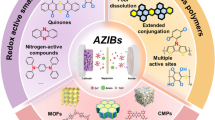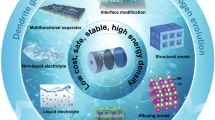Abstract
Ti/PbO2–TiO2–Ce(NO3)4 electrode for zinc electrowinning was prepared, and the effect of Ce(NO3)4 content on the electrochemical properties of zinc electrowinning anode was studied. Morphology and composition of the Ti/PbO2 electrode before and after polarization were analyzed by SEM and XRD. The corrosion mechanism was investigated by linear sweep voltammetry (LSV), cyclic voltammetry (CV) ,and electrochemical impedance spectroscopy (EIS) analyses. The cell voltage, current efficiency, corrosion rate, anode lifetime, and failure mechanism of Ti/PbO2 and Ti/PbO2–TiO2–Ce(NO3)4 were analyzed by simulating zinc electrowinning experiments. It was found that Ce(NO3)4 promoted the oxygen evolution reaction, and reduced the oxygen evolution potential and energy consumption. The analysis of oxygen evolution peak and reduction peak shows that Ti/PbO2–TiO2–Ce(NO3)4 electrode has good invertibility. In addition, it was found that the addition of Ce(NO3)4 increased the activity of the coating, and Ti/PbO2–TiO2–Ce(NO3)4 (0.5 g L−1) had the best activity. Compared with Ti/PbO2, the cell voltage of Ti/PbO2–TiO2–Ce(NO3)4 (0.5 g L−1) was reduced by 0.15 V, the current efficiency was improved by 4.3%, the corrosion rate was reduced by 0.0331 g A−1 h−1, and the lifetime was improved by 5 h.






Similar content being viewed by others
References
Y. Ortiz, A.R.D. Santos, A.M. Costa, E. Mavropoulos, M.N. Tanaka, M.H.P.D. Silva, In vitro assessment of zinc apatite coatings on titanium surfaces. Ceram. Int. 42, 15502 (2016)
M. Blumenau, M. Norden, F. Friedel, and K. Peters, Wetting force and contact angle measurements to evaluate the influence of zinc bath metallurgy on the galvanizability of high-manganese-alloyed steel. Surf. Coatings Technol. 205, 828 (2010)
R. Marder, The metallurgy of zinc-coated steel. Prog. Mater. Sci. 45, 191 (2000)
F.J. Pan, Z.Q. Liu, Industrial practices of concentration of germanium in process flowsheet of wet zinc smelting. Min. Metal. Eng. 24, 47 (2004)
C. Zhu, T. Zhou, F. Shi, W. Song, J. Li, W.J.A.P.A. Wu, Room-temperature RF magnetron sputtering deposition of hydrogenated Ga-doped ZnO thin films on PET substrates for PDLC devices. Appl. Phys. A 124, 850 (2018)
W. Lin, T. Xiao, W. Zhou, Z. Ning, Pb, Zn, and Cd distribution and Migration at a historical zinc smelting site. Pol. J. Environ. Stud. 24, 575 (2015)
N. Zheng, J.S. Liu, Q.C. Wang, Z. Z. Liang, Health risk assessment of heavy metal exposure to street dust in the zinc smelting district, Northeast of China. Sci. Total Environ. 408, 726 (2010)
Y. Huang, X. Zhang, H. Qiao, M. Hao, H. Zhang, Z. Xu, X. Zhang, X. Pang, and H. Lin, Corrosion resistance and cytocompatibility studies of zinc-doped fluorohydroxyapatite nanocomposite coatings on titanium implant. Ceram. Int. 42, 1903 (2016)
H.U. Xiang, C.Y. Wang, H.E. Zheng-Shan, Electro-catalytic oxidative degradation of aniline by modified graphite-based lead dioxide electrode. J. Beijing Univ. Technol. 37, 1756 (2011)
J. Zhu, X. Li, M.B. Liu, Y. Zhai, Lead based multi-alloy applied to anode of zinc electrowinning. Mater. Sci. Forum 658, 69 (2010)
C. Yang, and S.M. Park, Electrochemical behavior of PbO2 nanowires array anodes in a zinc electrowinning solution. Electrochim. Acta 108, 86 (2013)
S.D. Li, F.W. Wang, M. Xu, W.Y. Fang, X.Y. Yan, Preparation and Characterization of PbO2 Electrode Modified with Praseodymium. Adv. Mater. Res. 721, 37 (2013)
H.Y. Li, Y.H. Zhang, Y. Chen, W.Q. Han, L.J. Wang, Preparation and characterization of the novel Ti/PbO2 electrodes by electrodeposition and anodization. Adv. Mater. Res. 391–392, 1273 (2012)
C. Duan, J. Huo, F. Li, M. Yang, H. Xi, Ultrafast room-temperature synthesis of hierarchically porous metal–organic frameworks by a versatile cooperative template strategy. J. Mater. Sci. 53, 16276 (2018)
W. Zhang, S. Chen, M. He, G. Zhu, W. Yang, Y. Tian, Z. Zhang, S. Zhang, F. Zhang, Q. Wu, Enhanced photocatalytic properties of Bi4O5Br2 by Mn doping: a first principles study. Mater. Res. Express 5, 75512 (2018)
S.L. Hwang, P. Shen, H.T. Chu, T.F. Yui, Nanometer-size α-PbO2-Type TiO2 in garnet: a thermobarometer for ultrahigh-pressure metamorphism. Science 288, 321 (2000)
S. Clara Anthoniamma, H. Gurumallesh Prabu, Photocatalytic activity of TiO2 films prepared by sol–gel and electrodeposition on the decolourization of monoazo dyes. J. Sol-Gel. Sci. Technol. 73, 118 (2014)
X.J. Zhu, J. Deng, F.M. Gou, Study on preparation of modified ti-based lead dioxide electrode and degraded methylene blue. Adv. Mater. Res. 602–604, 1383 (2013)
W. Zhang, H. Lin, Z. Yang, H. Lu, T. Liu, High performance PbO2/AC asymmetric electrochemical capacitor based on lead dioxide electrode with three-dimensional porous titanium as substrate. Int. J. Hydrogen Energy 39, 17153 (2014)
Z. Pang, Q. Nie, Y. Zhu, M. Ge, M. Chen, Enhanced ammonia sensing characteristics of CeO2-decorated SiO2/PANI free-standing nanofibrous membranes. J. Mater. Sci. 54, 2333 (2018)
G. Hu, R. Xu, S. He, B. Chen, H. Yang, B. Yu, and Q. Liu, Electrosynthesis of Al/Pb/alpha-PbO2 composite inert anode materials. Trans. Nonferrous Metals Soc. China 25, 2095 (2015)
C. Zhang, J. Liu, B. Chen, Effect of CeO2 and graphite powder on the electrochemical performance of Ti/PbO2 anode for zinc electrowinning. Ceram. Int. 44, 19735 (2018)
J.C. Chunman Ho, A.C.M.Y. Tszyan Kwong, and S. Lai, Morphology-controllable synthesis of mesoporous ceo2 nano- and microstructures. Chem. Mater. 17, 4514 (2005)
T. Zhao, J. Lu, C. Hu, C. Zhu, J. Zhao, and W. Dong,Electrochemical degradation of 4, 4′-(propane-2, 2-diyl) diphenol in water with CeO2/β-PbO2/Ti electrode. Int. J. Electrochem. Sci. 9, 2354 (2014)
G. Wu, N. Li, C. Dai, D. Zhou, Anodically electrodeposited cobalt-nickel mixed oxide electrodes for oxygen evolution. Chin. J. Catal. 25, 319 (2004)
C. Young, A. Alfantazi, C. Anderson, A. James, D. Dreisinger, B. Harris, Effect of some polyols and organic acids on the current efficiency and the cell voltage during zinc electrowinning. Wiley, Hoboken (2013)
Acknowledgements
This work was supported by the funds for the construction of high-level talents of Kunming University of Science and Technology (KKKP201763019) and the Kunming University of Science and Technology Analysis Test Fund (2017T20170001).
Author information
Authors and Affiliations
Corresponding author
Additional information
Publisher’s Note
Springer Nature remains neutral with regard to jurisdictional claims in published maps and institutional affiliations.
Rights and permissions
About this article
Cite this article
Zhang, C., Liu, J. & Chen, B. Effect of Ce(NO3)4 on the electrochemical properties of Ti/PbO2–TiO2–Ce(NO3)4 electrode for zinc electrowinning. Appl. Phys. A 125, 150 (2019). https://doi.org/10.1007/s00339-019-2462-7
Received:
Accepted:
Published:
DOI: https://doi.org/10.1007/s00339-019-2462-7




